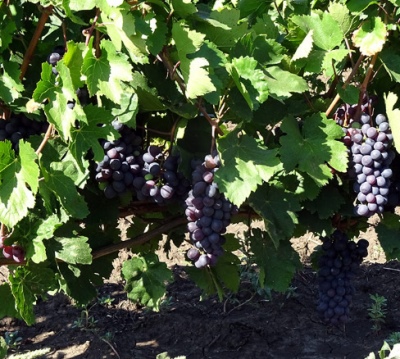
- Authors: Moldova
- Appointment: dining room
- Berry color: dark blue, covered with a rich waxy coating
- Taste: harmonious
- Ripening period: late
- Ripening period, days: 140
- Frost resistance, ° C: -15
- Name synonyms: Agrio Mavro, Agrio Mavro, Gara Kokur, Gara Kokur, Koarna Neagra, Coarna Neagra, Persia, Persia, Sultanka, Sultanca, Sultanka, Tirno Greiko, Tirno Greiko, Tyrno Greiko
- Bunch weight, g: 400-1000
- Yield: 80-120 c / ha
Moldavian grapes are in great demand among modern gardeners, and there are many reasons for this. It is tasty, can be stored for a long time, has many beneficial properties for the body.
Breeding history
The variety was bred in Moldova. And from there it spread throughout the world.
Description
Functionally female flowers form on the bushes of this variety. The bush is vigorous. Per plant, the percentage of fruitful shoots ranges from 63 to 68%. The fruiting factor is 0.8-1.
Ripening period
140 days is the ripening period for the fruits of this bush.
Bunches
Large clusters form on the plant, the shape of which can be described as conical. The density largely depends on how good the pollination was. The mass of one bunch can reach 1 kilogram, but there is no less than 400 grams.
Berries
Moldavian belongs to the table varieties. The fruits are excellently transported and have a marketability of 72 to 82%.
The color of the berries is dark blue, the wax bloom is clearly visible from above. The skin is firm and thick, the flesh is crispy inside. The fruits can reach a mass of 10 grams per grape.
Taste
The taste is assessed as harmonious.
Yield
Yields range from 80 to 120 centners per hectare.


Growing features
For any grape, the place where it is planted is important, and this variety is no exception. It is better for a gardener to choose a sunny area that is located on a small hillock so that the fruits can receive the required amount of heat. The landing site should not be blown by northerly winds.
As for moisture, Moldavian loves well-drained soil, which the gardener must take care of.
Landing
The seedlings are planted in small pits, 40x40 cm in size. After the first layer of soil is filled up, it must be lightly tamped with your hands to prevent the appearance of air pockets. At this stage, the seedling is lightly watered. When the planting pit is completely filled up, re-irrigate and cover the soil around with mulch. Coniferous bark can be used as it.

Pollination
Pollination is required, since only female flowers form on the bush.
Pruning
Moldavsky needs medium pruning, with the need for normalization.

Watering
With a lack of moisture in the soil, the berries of this variety become smaller, the vine grows worse, and as a result, the yield decreases. Therefore, if the soil is dry and there has been no rain for a long time, the grapes must be watered. Do not use cold water, the roots are sensitive to it. The average rate is 3-4 buckets of water per bush. After watering, the soil is loosened and mulched to retain moisture. Watering is stopped 2-3 weeks before the start of the harvest.


Top dressing
Simultaneously with watering, Moldavian grapes are fed. Complex mineral fertilizers with microelements, organic feeding are preferred: mullein infusion, bird droppings and ash.
In general, 4 root dressings are carried out per season. The first time - in early spring, the second - during the period of active growth of shoots and leaves (before flowering), and the third - phosphorus-potassium fertilizers are applied at the beginning of berry pouring. The fourth dressing is carried out after harvesting, it is necessary to accelerate the ripening and lignification of the shoots.
Fertilizers are best applied in solutions, feeding directly to the roots through holes or furrows.
Foliar dressing is carried out according to indications, if the plants wither, the color of the leaves changes. 2-3 days after foliar dressing, the grapes are sprayed with clean water to dissolve the fertilizer remaining on the leaves.
Foliar dressing with micronutrient fertilizers can accelerate the ripening of Moldavian grapes by about a week. To do this, take 10 g of boric acid, 5 g of zinc sulfate, 1 g of potassium permanganate, 8 g of ammonium molybdate. Each substance is dissolved separately and then subsequently diluted in 10 L of water.
When the plant has already sufficiently increased the green mass, a period of intensive berry growth begins. To stimulate the sugar content of berries, potassium phosphate supplements are used with the addition of 10 g of boric acid, 5 g of manganese sulfate, 1 g of potassium iodide. The presence of antiseptics (boric acid, potassium iodide) in the solution partially protects the fruits from decay.
Frost resistance and the need for shelter
Frost resistance is only -15 degrees, so when planting in regions with a temperate climate, you cannot do without shelter.

Diseases and pests
Disease resistance is low in Moldavian. On a five-point scale, immunity to mildew, oidium and gray rot is only 2.
At the beginning of ripening, the grapes are sprayed with baking soda (100 g / 10 l of water). This treatment prevents the development of gray mold and increases the sugar content of the fruit.
Immediately after flowering, Moldavian bushes must be treated with 1% Bordeaux liquid or other copper-containing preparations to prevent the spread of infection.
The main preventive measure against many diseases is treatment with Fitosporin every two weeks. Begin immediately after the leaves have opened. Berries can be eaten one day after spraying.

If a grape is exposed to any disease or insect, this always affects its appearance.
Storage
Grapes keep well if they provide the necessary conditions for this.











































































